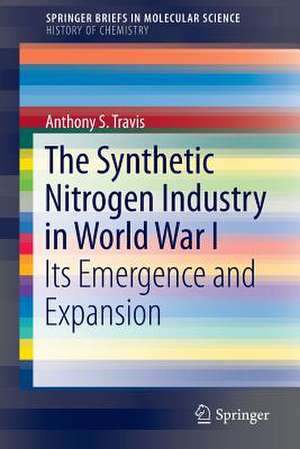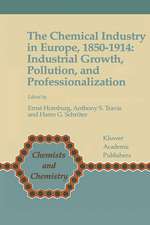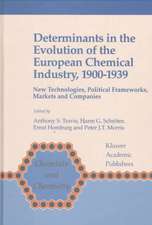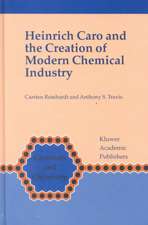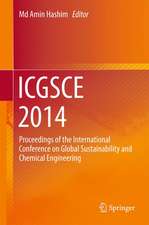The Synthetic Nitrogen Industry in World War I: Its Emergence and Expansion: SpringerBriefs in Molecular Science
Autor Anthony S. Travisen Limba Engleză Paperback – 21 iul 2015
Din seria SpringerBriefs in Molecular Science
-
 Preț: 411.46 lei
Preț: 411.46 lei -
 Preț: 379.09 lei
Preț: 379.09 lei -
 Preț: 356.49 lei
Preț: 356.49 lei -
 Preț: 441.25 lei
Preț: 441.25 lei -
 Preț: 389.70 lei
Preț: 389.70 lei -
 Preț: 376.22 lei
Preț: 376.22 lei -
 Preț: 348.77 lei
Preț: 348.77 lei -
 Preț: 345.14 lei
Preț: 345.14 lei -
 Preț: 347.69 lei
Preț: 347.69 lei -
 Preț: 346.70 lei
Preț: 346.70 lei -
 Preț: 376.43 lei
Preț: 376.43 lei -
 Preț: 342.14 lei
Preț: 342.14 lei -
 Preț: 375.23 lei
Preț: 375.23 lei -
 Preț: 375.23 lei
Preț: 375.23 lei -
 Preț: 379.09 lei
Preț: 379.09 lei -
 Preț: 376.59 lei
Preț: 376.59 lei - 15%
 Preț: 461.73 lei
Preț: 461.73 lei -
 Preț: 378.12 lei
Preț: 378.12 lei -
 Preț: 376.59 lei
Preț: 376.59 lei -
 Preț: 376.59 lei
Preț: 376.59 lei -
 Preț: 375.23 lei
Preț: 375.23 lei -
 Preț: 351.18 lei
Preț: 351.18 lei -
 Preț: 377.73 lei
Preț: 377.73 lei -
 Preț: 372.73 lei
Preț: 372.73 lei -
 Preț: 378.54 lei
Preț: 378.54 lei -
 Preț: 376.96 lei
Preț: 376.96 lei -
 Preț: 377.35 lei
Preț: 377.35 lei -
 Preț: 378.12 lei
Preț: 378.12 lei -
 Preț: 376.04 lei
Preț: 376.04 lei -
 Preț: 346.59 lei
Preț: 346.59 lei -
 Preț: 375.45 lei
Preț: 375.45 lei -
 Preț: 377.73 lei
Preț: 377.73 lei -
 Preț: 381.00 lei
Preț: 381.00 lei -
 Preț: 377.18 lei
Preț: 377.18 lei -
 Preț: 376.96 lei
Preț: 376.96 lei -
 Preț: 380.07 lei
Preț: 380.07 lei -
 Preț: 376.22 lei
Preț: 376.22 lei -
 Preț: 343.72 lei
Preț: 343.72 lei -
 Preț: 376.22 lei
Preț: 376.22 lei -
 Preț: 377.35 lei
Preț: 377.35 lei -
 Preț: 343.72 lei
Preț: 343.72 lei -
 Preț: 376.22 lei
Preț: 376.22 lei -
 Preț: 375.07 lei
Preț: 375.07 lei -
 Preț: 374.85 lei
Preț: 374.85 lei - 15%
 Preț: 464.97 lei
Preț: 464.97 lei -
 Preț: 376.43 lei
Preț: 376.43 lei -
 Preț: 341.75 lei
Preț: 341.75 lei -
 Preț: 374.30 lei
Preț: 374.30 lei -
 Preț: 375.23 lei
Preț: 375.23 lei -
 Preț: 377.57 lei
Preț: 377.57 lei
Preț: 381.21 lei
Nou
Puncte Express: 572
Preț estimativ în valută:
72.95€ • 79.22$ • 61.28£
72.95€ • 79.22$ • 61.28£
Carte tipărită la comandă
Livrare economică 22 aprilie-06 mai
Preluare comenzi: 021 569.72.76
Specificații
ISBN-13: 9783319193564
ISBN-10: 3319193562
Pagini: 110
Ilustrații: IX, 163 p. 66 illus., 16 illus. in color.
Dimensiuni: 155 x 235 x 12 mm
Greutate: 0.25 kg
Ediția:1st ed. 2015
Editura: Springer International Publishing
Colecția Springer
Seriile SpringerBriefs in Molecular Science, History of Chemistry
Locul publicării:Cham, Switzerland
ISBN-10: 3319193562
Pagini: 110
Ilustrații: IX, 163 p. 66 illus., 16 illus. in color.
Dimensiuni: 155 x 235 x 12 mm
Greutate: 0.25 kg
Ediția:1st ed. 2015
Editura: Springer International Publishing
Colecția Springer
Seriile SpringerBriefs in Molecular Science, History of Chemistry
Locul publicării:Cham, Switzerland
Public țintă
ResearchCuprins
Introduction.- Electric Arcs, Cyanamide, Carl Bosch, and Fritz Haber.- The Great War.- Concentrated Nitric Acid and Expansion of the Nitrogen Industry in Germany, France and Britain.- Nobel Prizes and New Technologies.- Conclusion: A Legacy of Synthetic Nitrogen.
Notă biografică
Anthony S. Travis, PhD, is deputy director of Sidney M. Edelstein Center for the History and Philosophy of Science, Technology and Medicine at the Hebrew University of Jerusalem. He has published extensively on the history of chemical technology in the 19th and 20th centuries. Currently he is undertaking research into the life of the British chemist Raphael Meldola, a close friend of Heinrich Caro and other leading German chemists, as well as of Charles Darwin. He is recipient of the American Chemical Society's History of Chemistry Division 2007 Edelstein Award in the history of chemistry.
Textul de pe ultima copertă
This concise brief describes how the demands of World War I, often referred to as the Chemists’ War, led to the rapid emergence of a new key industry based on fixation of atmospheric nitrogen. Then, as now, nitrogen products, including nitric acid, and nitrates, were essential for both fertilizers and in the manufacture of modern explosives. During the first decade of the twentieth century, this stimulated research into and application of novel processes. This book illustrates how from late 1914 the relations and developments in the first modern military-industrial complex enabled the great capital expenditures and technological advances that accelerated massive expansion, particularly of the BASF Haber-Bosch high-pressure process, that determined the direction of the post-war chemical industry.
Caracteristici
Describes the effects of wartime requirements for unprecedented amounts of explosives on German chemical research and industry during World War I Illustrates the historical development of all major processes aimed at nitrogen fixation for peacetime and military use Delineates the critical roles of Fritz Haber, Carl Bosch and other German chemists in the first modern military-industrial complex Includes supplementary material: sn.pub/extras
